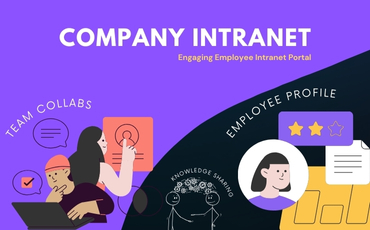“Networking is the No.1 unwritten rule of business success.” – Anonymous
In the dynamic era of corporate networking, understanding the nuances of Intranet and Extranet is crucial to enhancing your team’s collaboration, communication, and productivity.
These private networks serve different business use cases and security implications for companies. Most organizations leverage the benefits of both networks.
As the creators of a multipurpose intranet/extranet WordPress theme, we will explain intranets and extranets for corporate networking.
In this comprehensive guide, we will also explore intranet vs. extranet; various technologies used to set up these private networks, and their roles in shaping the modern corporate environment.
Ready to become a productivity hero? We’ve curated this ultimate guide based on our dedicated years of experience.
Internet vs. Intranet vs. Extranet
Internet
The Internet is a global public network with millions of computers interconnected to communicate and share information. It creates a communication medium with a web of networked devices that allows digital information to travel across wireless signals and data lines.
Benefits of Internet
It brings invaluable benefits to businesses and individuals alike. Given below are some of its benefits.
- Ability to reach unlimited markets
- Low-cost marketing
- Ease of transactions
- Access to information
- Internal & External communication
Drawbacks of Internet
- Malware & data thefts
- Impersonalization
- High competition
Intranet
An intranet is a private, secure network that employees use for information sharing and internal communication within a company. You can access it across a building, a region, or a country. It focuses on internal collaboration, data sharing, and communication.
It has key features such as staff information management, content management, staff communication & collaboration, projects & task management, learning management, and staff self-service tools.
Benefits of Intranet
- Involves only specific users
- Improves internal communication & collaboration
- Cost-effective for business management
- Provides platform independence
- Enhances employee productivity
- Provides immediate updates, whenever necessary
Drawbacks of Intranet
- Security threats
- Costly implementation
- Complex to maintain
Extranet
It is also a private, secure network that aims at sharing business information with partners, suppliers, current & potential customers, vendors, and other business partners. It establishes a central hub of communication between the organizations and outside parties. However, it works well in synergy with the intranet.
The key features of the extranet include collaboration with business partners, communication with customers, and customer self-service.
Benefits of Extranet
- Streamlined business process management
- High security of data
- Increased customer satisfaction
Drawbacks of Extranet
- Implementation & maintenance costs
- Certain compromised security issues
Key differences between Internet, Intranet & Extranet
| Basis of Comparison | Internet | Intranet | Extranet |
| Network size | It is a public network with an unlimited number of connected devices. | It is a private network with a small number of connected devices. | It is also a private network with a limited number of connected devices. |
| Regulation | Not regulated by any private authority. However, ICANN in the USA manages the protocols related to it. | Regulated by a single company that owns it. | Regulated by one or multiple companies. |
| Purpose | To communicate and share information worldwide. | To share corporate data among employees within the company. | To promote collaboration & communication between the company’s employees and external members. |
| Security | It depends upon the user and the device connected to the network. | It is secured by a firewall. | It is secured by VPNs and a firewall. |
| Setup policies | No hard and fast rule. | Organizational policies are imposed. | Organizational policies are imposed. |
| Maintenance | Maintained by ISP. | Maintained by HR, CIO, or communication department of a company. | Maintained by HR, CIO, or communication department of a company. |
| User training | No previous user training. | May require previous user training. | May require previous user training. |
| Access | Unrestricted and can be used anonymously. | Accessed by authorized users only. | Accessed by authorized users only. |
Why do companies use intranet/extranet?
Companies need to build systems for better organization of business processes, especially when things are becoming chaotic in advanced technological environments.
Intranets/Extranets provide centralized hubs for information, streamline workflows, and offer secure platforms for collaboration with internal teams and external partners.
There’s almost zero chance of your teammates missing important company news, corporate emails, crucial documents, casual talks, and more with an effective intranet/extranet in place.
Given below are the seven reasons companies use intranet/extranet platforms.
Central information hub
Companies use intranets to centralize policies and send circulars, guidelines, and important company updates in one shared location. Thus, it acts as a trustworthy central hub where each stakeholder and employee finds relevant sources of information.
Team collaboration
It fosters real-time collaboration where employees can discuss project progress, hold virtual meetings, or share documents to ensure everyone is on the same page.
Employee engagement
An effective intranet setup contains many engagement features like sending birthday wishes, appreciating employees with recognition boards, social interaction activities, etc. It gives each employee a sense of belongingness to their company and team.
Task management
Intranets often integrate task management tools and workflow automation, allowing teams to organize and prioritize tasks efficiently. It ensures smoother project progress and timely completion of assignments.
Document management
Intranet/extranet platforms offer collaborative document sharing with features including directory, wiki, or integration with tools like Slack, Google Drive, etc.
Secure collaboration with external parties
External partners also look forward to a secure network. It is possible via extranets. It’s an effective and productive platform to collaborate with and share supply chain information, inventory levels, ongoing business schedules, and more with your suppliers.
Confidential data sharing
A law firm establishes an Extranet to securely share confidential legal documents with external legal teams working on collaborative cases. It ensures the confidentiality of sensitive information.
Similarly, government organizations, healthcare institutions, or educational institutions set up intranet/extranet.
How do companies set up intranet/extranet networks?
Setting up an intranet/extranet involves various steps. The approach followed by each company may vary based on the requirements and chosen technology stack.
Without further delay, let’s learn the common steps companies follow to set up intranet/extranet networks below!
How do companies set up an intranet?
Step 1: Choose a platform
First and foremost, a company chooses a technology stack to build a secure intranet network. They may choose among custom-built solutions, dedicated cloud-based or other software, or multipurpose intranet/extranet WordPress themes.
Step 2: Outline underlying aims
A company looks forward to improved collaboration and communication when it builds an intranet/extranet. This step clearly outlines further objectives. The company identifies the features needed, such as forums, document repositories, and employee directories.
Step 3: Development/Customization
If opting for a custom solution, the company may engage in design and development, creating a user-friendly interface and incorporating essential features. You can explore customization options for pre-built solutions.
Step 4: Deployment
The step includes the implementation of an intranet network. It includes installing server software, configuration, or ensuring compatibility with the existing company’s infrastructure.
Step 5: User training
Although most intranet networks are tech-savvy, training is still required to teach employees how to leverage the network to their full potential. It could include giving guidance on how to use features, upload documents, and engage in collaborative activities.
Step 6: Security measures
Now, the company is considering implementing robust security measures to protect sensitive company information. Security concerns are taken into account while choosing the platform.
Step 7: Regular updates & maintenance
Intranet network providers give regular updates and maintenance notifications to their customers. Thus, this step involves receiving regular updates or addressing any issues promptly with the concerned support team.
How do companies set up an extranet?
Step 1: Identify external partners
Identify the external parties like suppliers, partners, and clients the company needs to collaborate with. Communicate the purpose and benefits of the collaboration to external parties.
Step 2: Security Protocols
The step involves implementing stringent security protocols to ensure that only authorized persons can access the network. Consider checking user authentication, SSL certificates, data encryption, etc.
Step 3: Defining control access
Define access levels for external users, specifying the information and features they can access. It helps maintain data confidentiality and integrity.
Step 4: Collaboration tools
Integrate collaboration features such as team management, project management, task management, and communication functions to facilitate smooth collaboration between internal and external teams.
Step 5: User onboarding
The step involves providing external users with onboarding support, including instructions on accessing the extranet network, setting up accounts, and using collaborative tools.
Step 6: Scalability planning
Do proper planning to meet the growing collaboration needs. It focuses on ensuring that the extranet can handle increased user loads and data volumes.
How do you choose a reliable intranet/extranet platform for your company?
Both intranets and extranets provide companies with the ability to organize a collaborative digital workspace.
An intranet is the best match for you if you need a platform that improves internal communication, and information exchange, and boosts the employee experience.
On the contrary, investing in an extranet platform is the right idea if you foster strong relationships with business partners, customers, vendors, and suppliers.
We recommend choosing the platform based on your requirements. Compare the cost involved after you find your desired features in a specified platform. You can also consider the ease of learning curve with each platform. Check technical aspects as well because you must ultimately share the access with your teammates to let them communicate smoothly.
They might resist or won’t like using a platform that’s too hard to learn. Thus, you must check how easy it is to use the specific intranet/extranet network you’re deploying for your company members or external business partners.
Using BuddyPress-based WordPress theme to set up intranet/extranet
You can unlock an affordable solution with a BuddyPress-based WordPress theme to set up an intranet/extranet network for your company, an educational institution, or a government enterprise.
It is one of the less complicated methods to set up an intranet/extranet among all other platforms. Opting for a BuddyPress-based theme means aligning with a solution that has gained widespread adoption in the WordPress community.
A theme signifies reliability when widely used. Trust is maintained when you join the ranks of satisfied users. Moreover, a robust theme often comes with a dedicated support team ready to assist you at every turn.
How can Woffice help?
We have developed Woffice to provide a cost-effective yet multipurpose WordPress theme. It helps smoothly set up an intranet/extranet network. Our team is super active in building Woffice’s add-ons or plugins.
Our add-ons are designed, developed, and categorized while checking the global user’s requirements. We actively address customers’ issues and spread smiles to more than 14,000 users worldwide.
What’s the BIG PLUS? Every day we make enhancements to improve the overall user experience of Woffice.
At the time of writing this post, design bug fixes and other improvements are in progress and we’ve just finished the entire migration of the theme from the Unyson to the Redux framework two months ago.
We have add-ons for both the intranet and extranet functionality. And, you can choose plugins based on whether you want to build an extranet or an intranet platform.
Woffice caters to various use cases and is not just limited to building a collaboration platform for employees. You can consider using Woffice for building an intranet platform for educational institutions, healthcare providers, government agencies, or small to medium-sized manufacturing companies.
As we conclude this definitive guide, it’s evident that understanding the nuances between intranet and extranet is the key to fostering collaboration, boosting productivity, and fortifying organizational bonds. Intranets serve as the beating heart of internal communication. On the other hand, Extranets extend the reach beyond company borders. The synergy between these two components creates a robust network that not only facilitates efficient workflow but also propels businesses toward innovation and growth.
Consider leveraging the power of WordPress themes if you’re ready to transform your internal and external communication seamlessly. Seize the opportunity with Woffice today, and let your corporate network be the catalyst for success.


 "
"



